This set of Biophysics Multiple Choice Questions & Answers (MCQs) focuses on “Diffusion – Set 2”.
1. Assume a biological membrane with a surface area of 10 cm2 and the permeability constant of this membrane is 10 cm/sec2. If the concentration gradient of a particular molecule towards inside of the cell is 10 mole/cm2 then what is diffusion rate across the membrane?
a) 250 mole/sec
b) 500 mole/sec
c) 1000 mole/sec
d) 2000 mole/sec
View Answer
Explanation: The diffusion rate is the multiplication of membrane permeability constant, membrane surface area, and concentration gradient. Therefore, here, diffusion rate will be 10*10*10 = 1000 mole/sec.
2. Imagine the concentrations of a particular molecule across a 1000 nm width biological membrane are 10 moles and 20 moles respectively in inside and outside of the cell. Now, if the permeability constant of that membrane is 10 cm/sec and the membrane surface area is 20 cm2, then what will be the diffusion rate across the membrane?
a) 2*107 mole/sec
b) 3*107 mole/sec
c) 2*107 mole/sec
d) 3*107 mole/sec
View Answer
Explanation: The equation for diffusion rate is R = P *A * [dc/dx].
Where R is the diffusion rate, P is the permeability constant, A is the area of the membrane, dc is the difference in concentration across the membrane and dx is the width of the cell.
So the diffusion rate is R = 10 * 20 * [10 / (1000 * 10-7)] = 2*107 mole/sec.
3. Consider the following oval image as a mammalian cell. The concentrations of a 50 KD hydrophilic protein, named as ‘protein A’ are mentioned in the image. Choose the correct option.
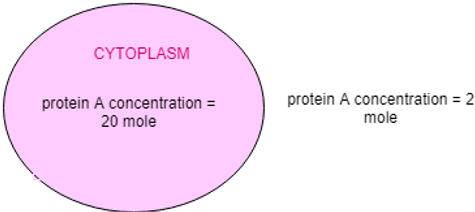
a) Protein A will move from the outer surface to the cell cytoplasm
b) Protein A will move from cell cytoplasm to the outer surface of the cell
c) Protein A will move from cytoplasm to the intermembrane space
d) There will not be any movement of protein A
View Answer
Explanation: It is mentioned in the question that the protein is 50kd which is very large. Plasma membrane doesn’t allow such a bigger molecule to pass. Secondly, the protein is hydrophilic which will be repealed by the hydrophobic core of the membrane, thereby the protein will not be transported across the membrane.
4. Choose the correct relation between simple diffusion rate and concentration gradient.
a)
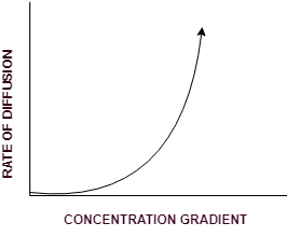
b)
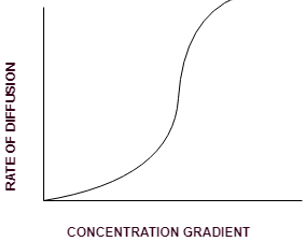
c)
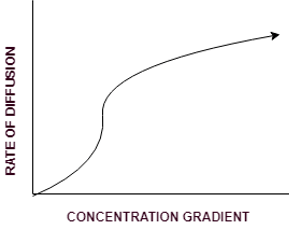
d)
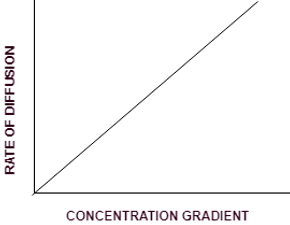
View Answer
Explanation: In case of simple diffusion, the rate of the diffusion is directly proportional to the concentration gradient of the molecule. So the graph for this equation will follow y=mx equation and will be a straight line passing through the origin.
5. Choose the correct relation between simple diffusion rate and width of the cell membrane.
a)
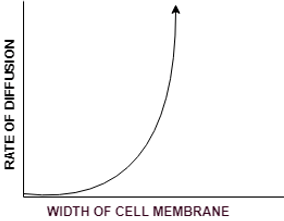
b)
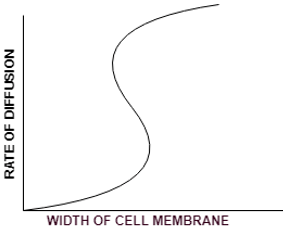
c)
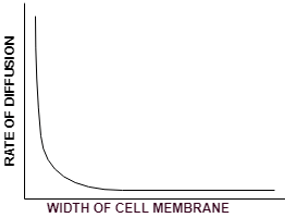
d)
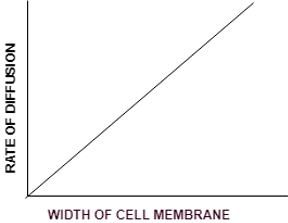
View Answer
Explanation: According to Fick’s law, the rate of diffusion is inversely proportional to the width of the cell membrane. So, following y = 1 / x equation, the correction option is C. This graphs have only positive values because the rate cannot be negative.
6. The below curve is showing a relation between two parameters in facilitated diffusion. Find the two parameters mentioned in the format Y axis vs X axis.
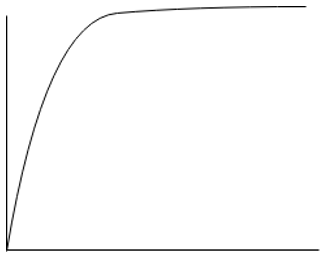
a) Diffusion rate vs Concentration gradient
b) Diffusion rate vs Width of the membrane
c) Concentration vs Permeability constant of that molecule
d) Permeability constant vs Concentration
View Answer
Explanation: In facilitated diffusion, the molecules to be transported are carried by carrier molecules. So initially the rate increases exponentially but after some time all the carrier molecules gets saturated with substrate molecules.
7. Which one of the following options require ATP?
a) Simple diffusion
b) Facilitated transport
c) Active transport
d) Carrier-mediated diffusion
View Answer
Explanation: In simple diffusion, facilitated diffusion and in carrier-mediated diffusion, the transport occurs from higher to lower concentration which is a thermodynamically favorable process. The reverse of this process that is uphill transport is carried out by Active transport. Therefore, active transport requires ATP.
8. Imagine a biological membrane with surface area 10 cm2. The diffusion rate of the molecule ‘A’ is 2000 mole/sec. The concentration of molecule A across the membrane is 20 mole/cm2. What is the permeability constant of the molecule A?
a) 1000
b) 50
c) 20
d) 10
View Answer
Explanation: According to the modified Fick’s law, rate of diffusion = permeability constant of the molecule * area of membrane * concentration gradient of the molecule. So permeability constant = 2000 / (10 * 20) = 10 mole/sec.
9. ‘P’ is a membrane permeable molecule. The concentration of P is 60 mole and 30 moles in outside and inside of the cell membrane respectively. What will be the ΔG for diffusion for the transport of molecule from outside to inside of the cell at STP?
a) ΔG will be positive
b) ΔG will be negative
c) ΔG will be zero
d) ΔG cannot be determined due to limited information
View Answer
Explanation: According to the thermodynamic rule of transport, ΔG=RT ln(Cinside/Coutside). Where the characters bear the standard nomenclature. Now, given concentration of outside > inside. Therefore ΔG will be negative.
10. For a membrane permeable molecule, the concentration of the molecule is 100 mole outside the cell and 50 moles inside the cell. What is the ΔG for diffusion for the transport of molecule from outside to inside of the cell at 27°C and 1 atm pressure?
a) – 1729
b) + 1729
c) +3256
d) -3256
View Answer
Explanation: The ΔG for the transport of molecules = RT ln (Cinside/Coutside). The standard values of R = 8.314 joules. So ΔG = 8.314 * (273+27) * ln (50/100) = -1729.159.
11. A charged ion can easily diffuse through the biological membrane depending on its positive concentration gradient.
a) True
b) False
View Answer
Explanation: The core of the membrane is highly hydrophobic which does not allow any polar residues or any charged residues. So, even in the presence of a higher concentration gradient, there will be no direct flow of ions through the membrane.
12. ________________ requires a carrier to be transported but does not need any energy for the transportation.
a) Active transport
b) Channel-mediated active diffusion
c) Simple diffusion
d) Facilitated diffusion
View Answer
Explanation: Through Facilitated diffusion, those molecules which are polar but small in size, are transported through the membrane with the help of carrier molecules. Most importantly, this process is an energetically favorable downhill transport process, so doesn’t require energy.
13. Which law is called the law of diffusion?
a) Fick’s law
b) Newton’s law
c) Henry’s law
d) Kopp’s law
View Answer
Explanation: Fick’s law is the law of diffusion which first stated that the rate of diffusion is proportional to the concentration gradient of the molecule across the membrane. The rest of the laws except newton’s law, explains the thermodynamic principle.
14. What is the unit of the rate of diffusion?
a) Mole. S-2
b) Cm. S-1
c) Mole. S-1
d) Mole. S-3
View Answer
Explanation: Diffusion rate is the number of molecules that enters the cell per unit time. So the correct unit is moles per second.
15. What is the unit of the diffusion coefficient of a particular small nonpolar molecule?
a) Mole.S-1
b) Cm2. S
c) Cm. S-1
d) Cm 2. S-1
View Answer
Explanation: The unit of the diffusion coefficient is calculated from Fick’s law. The law is J = -D * ΔC/Δx. The characters signify standard nomenclature. Where the unit of J = gm. cm-2. S-1, unit of ΔC/Δx = gm. Cm-4. Now, comparing both hand side of the equation, the unit of diffusion coefficient D = Cm2.S-1.
Sanfoundry Global Education & Learning Series – Biophysics.
To practice all areas of Biophysics, here is complete set of 1000+ Multiple Choice Questions and Answers.
If you find a mistake in question / option / answer, kindly take a screenshot and email to [email protected]
